Case Study Analysis: Mary's Wound Infection and Treatment in Hospital
VerifiedAdded on 2020/10/22
|5
|1880
|205
Case Study
AI Summary
This case study examines a 21-year-old patient, Mary, admitted with an infected laceration on her left foot. The assignment delves into the physiological basis of the wound, including signs of infection like swelling, purulent discharge, redness, and warmth. It explores both endogenous and exogenous sources of contamination, such as bacterial flora and infected objects. The case study details the rationale behind the choice of antibiotics, including ceftriaxone, cephalexin, and dicloxacillin, and their respective roles in treating the infection. Furthermore, it outlines the adverse reactions to dicloxacillin and describes the process of wound healing, including rapid haemostasis, inflammation, proliferation, angiogenesis, and reepitheliazation. The assignment references relevant literature to support the analysis and treatment plan.
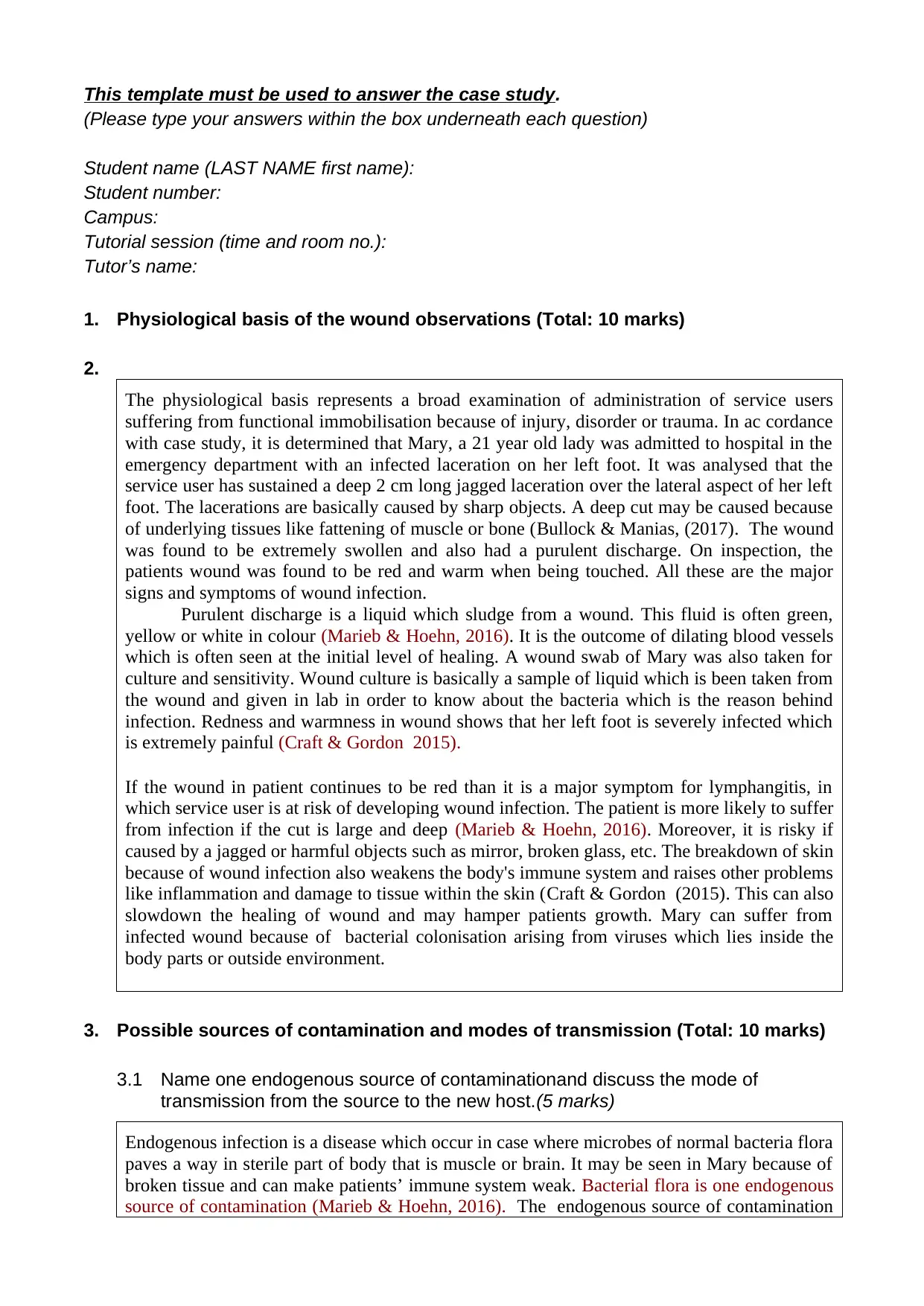
This template must be used to answer the case study.
(Please type your answers within the box underneath each question)
Student name (LAST NAME first name):
Student number:
Campus:
Tutorial session (time and room no.):
Tutor’s name:
1. Physiological basis of the wound observations (Total: 10 marks)
2.
The physiological basis represents a broad examination of administration of service users
suffering from functional immobilisation because of injury, disorder or trauma. In ac cordance
with case study, it is determined that Mary, a 21 year old lady was admitted to hospital in the
emergency department with an infected laceration on her left foot. It was analysed that the
service user has sustained a deep 2 cm long jagged laceration over the lateral aspect of her left
foot. The lacerations are basically caused by sharp objects. A deep cut may be caused because
of underlying tissues like fattening of muscle or bone (Bullock & Manias, (2017). The wound
was found to be extremely swollen and also had a purulent discharge. On inspection, the
patients wound was found to be red and warm when being touched. All these are the major
signs and symptoms of wound infection.
Purulent discharge is a liquid which sludge from a wound. This fluid is often green,
yellow or white in colour (Marieb & Hoehn, 2016). It is the outcome of dilating blood vessels
which is often seen at the initial level of healing. A wound swab of Mary was also taken for
culture and sensitivity. Wound culture is basically a sample of liquid which is been taken from
the wound and given in lab in order to know about the bacteria which is the reason behind
infection. Redness and warmness in wound shows that her left foot is severely infected which
is extremely painful (Craft & Gordon 2015).
If the wound in patient continues to be red than it is a major symptom for lymphangitis, in
which service user is at risk of developing wound infection. The patient is more likely to suffer
from infection if the cut is large and deep (Marieb & Hoehn, 2016). Moreover, it is risky if
caused by a jagged or harmful objects such as mirror, broken glass, etc. The breakdown of skin
because of wound infection also weakens the body's immune system and raises other problems
like inflammation and damage to tissue within the skin (Craft & Gordon (2015). This can also
slowdown the healing of wound and may hamper patients growth. Mary can suffer from
infected wound because of bacterial colonisation arising from viruses which lies inside the
body parts or outside environment.
3. Possible sources of contamination and modes of transmission (Total: 10 marks)
3.1 Name one endogenous source of contaminationand discuss the mode of
transmission from the source to the new host.(5 marks)
Endogenous infection is a disease which occur in case where microbes of normal bacteria flora
paves a way in sterile part of body that is muscle or brain. It may be seen in Mary because of
broken tissue and can make patients’ immune system weak. Bacterial flora is one endogenous
source of contamination (Marieb & Hoehn, 2016). The endogenous source of contamination
(Please type your answers within the box underneath each question)
Student name (LAST NAME first name):
Student number:
Campus:
Tutorial session (time and room no.):
Tutor’s name:
1. Physiological basis of the wound observations (Total: 10 marks)
2.
The physiological basis represents a broad examination of administration of service users
suffering from functional immobilisation because of injury, disorder or trauma. In ac cordance
with case study, it is determined that Mary, a 21 year old lady was admitted to hospital in the
emergency department with an infected laceration on her left foot. It was analysed that the
service user has sustained a deep 2 cm long jagged laceration over the lateral aspect of her left
foot. The lacerations are basically caused by sharp objects. A deep cut may be caused because
of underlying tissues like fattening of muscle or bone (Bullock & Manias, (2017). The wound
was found to be extremely swollen and also had a purulent discharge. On inspection, the
patients wound was found to be red and warm when being touched. All these are the major
signs and symptoms of wound infection.
Purulent discharge is a liquid which sludge from a wound. This fluid is often green,
yellow or white in colour (Marieb & Hoehn, 2016). It is the outcome of dilating blood vessels
which is often seen at the initial level of healing. A wound swab of Mary was also taken for
culture and sensitivity. Wound culture is basically a sample of liquid which is been taken from
the wound and given in lab in order to know about the bacteria which is the reason behind
infection. Redness and warmness in wound shows that her left foot is severely infected which
is extremely painful (Craft & Gordon 2015).
If the wound in patient continues to be red than it is a major symptom for lymphangitis, in
which service user is at risk of developing wound infection. The patient is more likely to suffer
from infection if the cut is large and deep (Marieb & Hoehn, 2016). Moreover, it is risky if
caused by a jagged or harmful objects such as mirror, broken glass, etc. The breakdown of skin
because of wound infection also weakens the body's immune system and raises other problems
like inflammation and damage to tissue within the skin (Craft & Gordon (2015). This can also
slowdown the healing of wound and may hamper patients growth. Mary can suffer from
infected wound because of bacterial colonisation arising from viruses which lies inside the
body parts or outside environment.
3. Possible sources of contamination and modes of transmission (Total: 10 marks)
3.1 Name one endogenous source of contaminationand discuss the mode of
transmission from the source to the new host.(5 marks)
Endogenous infection is a disease which occur in case where microbes of normal bacteria flora
paves a way in sterile part of body that is muscle or brain. It may be seen in Mary because of
broken tissue and can make patients’ immune system weak. Bacterial flora is one endogenous
source of contamination (Marieb & Hoehn, 2016). The endogenous source of contamination
Paraphrase This Document
Need a fresh take? Get an instant paraphrase of this document with our AI Paraphraser
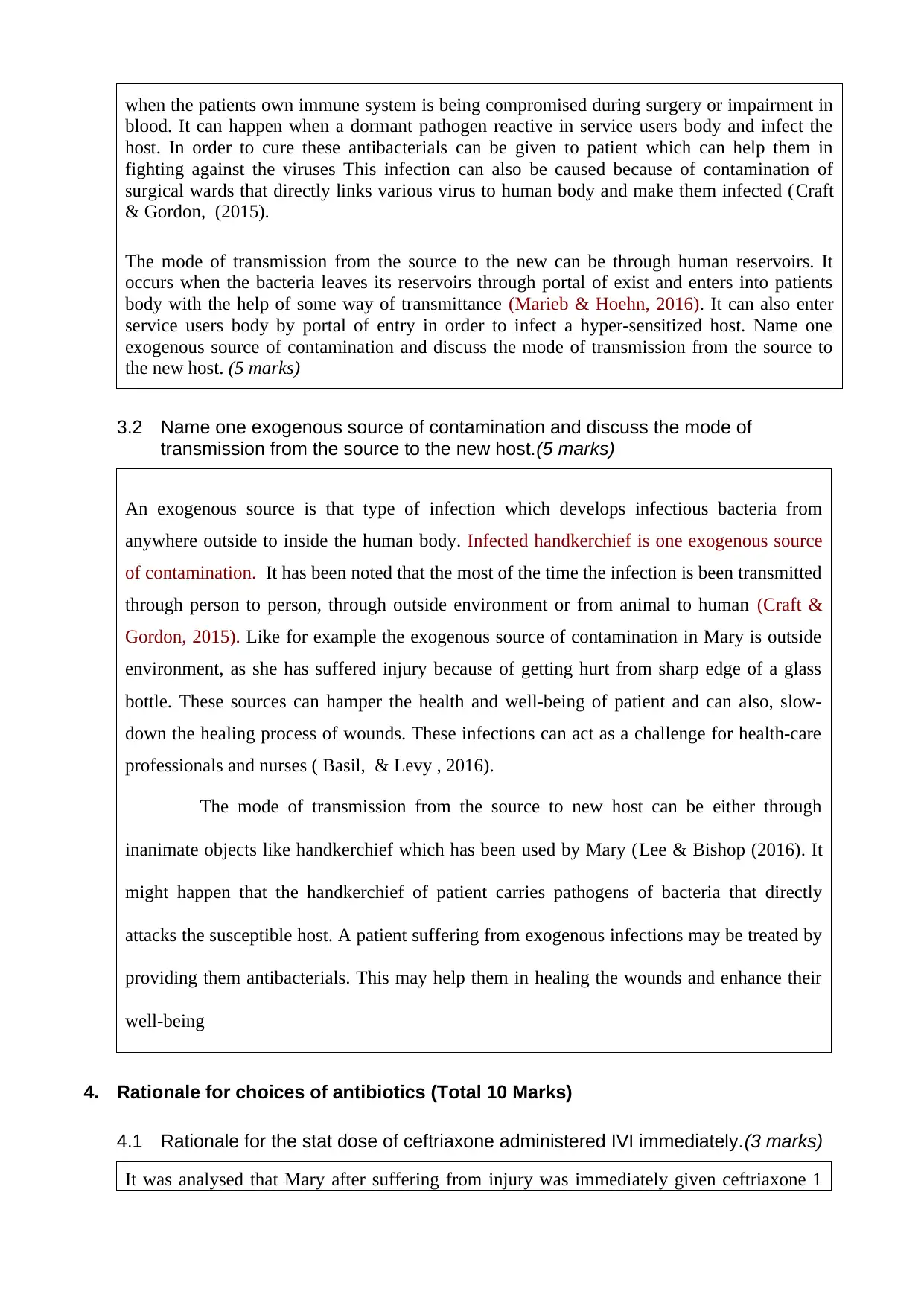
when the patients own immune system is being compromised during surgery or impairment in
blood. It can happen when a dormant pathogen reactive in service users body and infect the
host. In order to cure these antibacterials can be given to patient which can help them in
fighting against the viruses This infection can also be caused because of contamination of
surgical wards that directly links various virus to human body and make them infected (Craft
& Gordon, (2015).
The mode of transmission from the source to the new can be through human reservoirs. It
occurs when the bacteria leaves its reservoirs through portal of exist and enters into patients
body with the help of some way of transmittance (Marieb & Hoehn, 2016). It can also enter
service users body by portal of entry in order to infect a hyper-sensitized host. Name one
exogenous source of contamination and discuss the mode of transmission from the source to
the new host. (5 marks)
3.2 Name one exogenous source of contamination and discuss the mode of
transmission from the source to the new host.(5 marks)
An exogenous source is that type of infection which develops infectious bacteria from
anywhere outside to inside the human body. Infected handkerchief is one exogenous source
of contamination. It has been noted that the most of the time the infection is been transmitted
through person to person, through outside environment or from animal to human (Craft &
Gordon, 2015). Like for example the exogenous source of contamination in Mary is outside
environment, as she has suffered injury because of getting hurt from sharp edge of a glass
bottle. These sources can hamper the health and well-being of patient and can also, slow-
down the healing process of wounds. These infections can act as a challenge for health-care
professionals and nurses ( Basil, & Levy , 2016).
The mode of transmission from the source to new host can be either through
inanimate objects like handkerchief which has been used by Mary (Lee & Bishop (2016). It
might happen that the handkerchief of patient carries pathogens of bacteria that directly
attacks the susceptible host. A patient suffering from exogenous infections may be treated by
providing them antibacterials. This may help them in healing the wounds and enhance their
well-being
4. Rationale for choices of antibiotics (Total 10 Marks)
4.1 Rationale for the stat dose of ceftriaxone administered IVI immediately.(3 marks)
It was analysed that Mary after suffering from injury was immediately given ceftriaxone 1
blood. It can happen when a dormant pathogen reactive in service users body and infect the
host. In order to cure these antibacterials can be given to patient which can help them in
fighting against the viruses This infection can also be caused because of contamination of
surgical wards that directly links various virus to human body and make them infected (Craft
& Gordon, (2015).
The mode of transmission from the source to the new can be through human reservoirs. It
occurs when the bacteria leaves its reservoirs through portal of exist and enters into patients
body with the help of some way of transmittance (Marieb & Hoehn, 2016). It can also enter
service users body by portal of entry in order to infect a hyper-sensitized host. Name one
exogenous source of contamination and discuss the mode of transmission from the source to
the new host. (5 marks)
3.2 Name one exogenous source of contamination and discuss the mode of
transmission from the source to the new host.(5 marks)
An exogenous source is that type of infection which develops infectious bacteria from
anywhere outside to inside the human body. Infected handkerchief is one exogenous source
of contamination. It has been noted that the most of the time the infection is been transmitted
through person to person, through outside environment or from animal to human (Craft &
Gordon, 2015). Like for example the exogenous source of contamination in Mary is outside
environment, as she has suffered injury because of getting hurt from sharp edge of a glass
bottle. These sources can hamper the health and well-being of patient and can also, slow-
down the healing process of wounds. These infections can act as a challenge for health-care
professionals and nurses ( Basil, & Levy , 2016).
The mode of transmission from the source to new host can be either through
inanimate objects like handkerchief which has been used by Mary (Lee & Bishop (2016). It
might happen that the handkerchief of patient carries pathogens of bacteria that directly
attacks the susceptible host. A patient suffering from exogenous infections may be treated by
providing them antibacterials. This may help them in healing the wounds and enhance their
well-being
4. Rationale for choices of antibiotics (Total 10 Marks)
4.1 Rationale for the stat dose of ceftriaxone administered IVI immediately.(3 marks)
It was analysed that Mary after suffering from injury was immediately given ceftriaxone 1
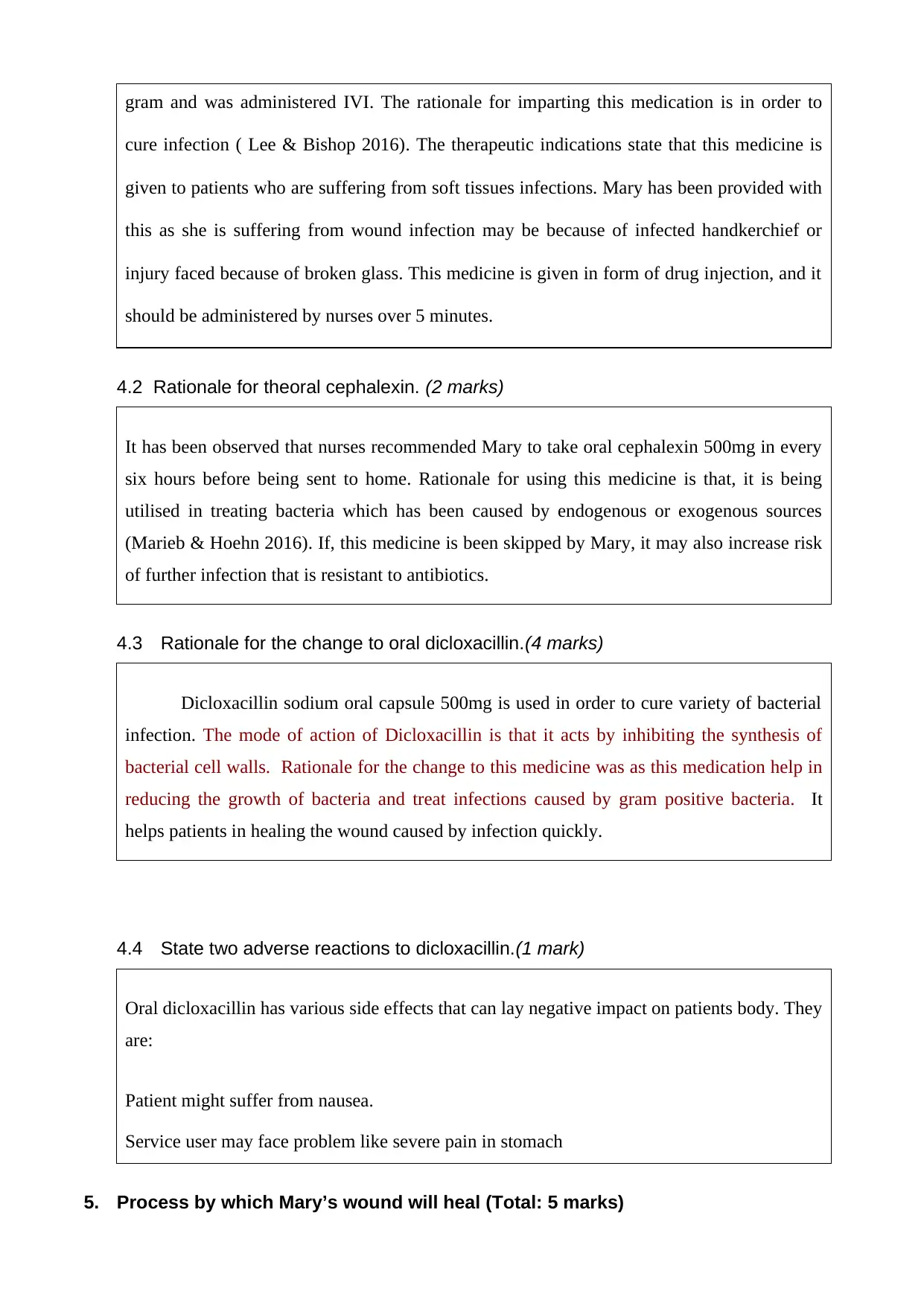
gram and was administered IVI. The rationale for imparting this medication is in order to
cure infection ( Lee & Bishop 2016). The therapeutic indications state that this medicine is
given to patients who are suffering from soft tissues infections. Mary has been provided with
this as she is suffering from wound infection may be because of infected handkerchief or
injury faced because of broken glass. This medicine is given in form of drug injection, and it
should be administered by nurses over 5 minutes.
4.2 Rationale for theoral cephalexin. (2 marks)
It has been observed that nurses recommended Mary to take oral cephalexin 500mg in every
six hours before being sent to home. Rationale for using this medicine is that, it is being
utilised in treating bacteria which has been caused by endogenous or exogenous sources
(Marieb & Hoehn 2016). If, this medicine is been skipped by Mary, it may also increase risk
of further infection that is resistant to antibiotics.
4.3 Rationale for the change to oral dicloxacillin.(4 marks)
Dicloxacillin sodium oral capsule 500mg is used in order to cure variety of bacterial
infection. The mode of action of Dicloxacillin is that it acts by inhibiting the synthesis of
bacterial cell walls. Rationale for the change to this medicine was as this medication help in
reducing the growth of bacteria and treat infections caused by gram positive bacteria. It
helps patients in healing the wound caused by infection quickly.
4.4 State two adverse reactions to dicloxacillin.(1 mark)
Oral dicloxacillin has various side effects that can lay negative impact on patients body. They
are:
Patient might suffer from nausea.
Service user may face problem like severe pain in stomach
5. Process by which Mary’s wound will heal (Total: 5 marks)
cure infection ( Lee & Bishop 2016). The therapeutic indications state that this medicine is
given to patients who are suffering from soft tissues infections. Mary has been provided with
this as she is suffering from wound infection may be because of infected handkerchief or
injury faced because of broken glass. This medicine is given in form of drug injection, and it
should be administered by nurses over 5 minutes.
4.2 Rationale for theoral cephalexin. (2 marks)
It has been observed that nurses recommended Mary to take oral cephalexin 500mg in every
six hours before being sent to home. Rationale for using this medicine is that, it is being
utilised in treating bacteria which has been caused by endogenous or exogenous sources
(Marieb & Hoehn 2016). If, this medicine is been skipped by Mary, it may also increase risk
of further infection that is resistant to antibiotics.
4.3 Rationale for the change to oral dicloxacillin.(4 marks)
Dicloxacillin sodium oral capsule 500mg is used in order to cure variety of bacterial
infection. The mode of action of Dicloxacillin is that it acts by inhibiting the synthesis of
bacterial cell walls. Rationale for the change to this medicine was as this medication help in
reducing the growth of bacteria and treat infections caused by gram positive bacteria. It
helps patients in healing the wound caused by infection quickly.
4.4 State two adverse reactions to dicloxacillin.(1 mark)
Oral dicloxacillin has various side effects that can lay negative impact on patients body. They
are:
Patient might suffer from nausea.
Service user may face problem like severe pain in stomach
5. Process by which Mary’s wound will heal (Total: 5 marks)
⊘ This is a preview!⊘
Do you want full access?
Subscribe today to unlock all pages.

Trusted by 1+ million students worldwide
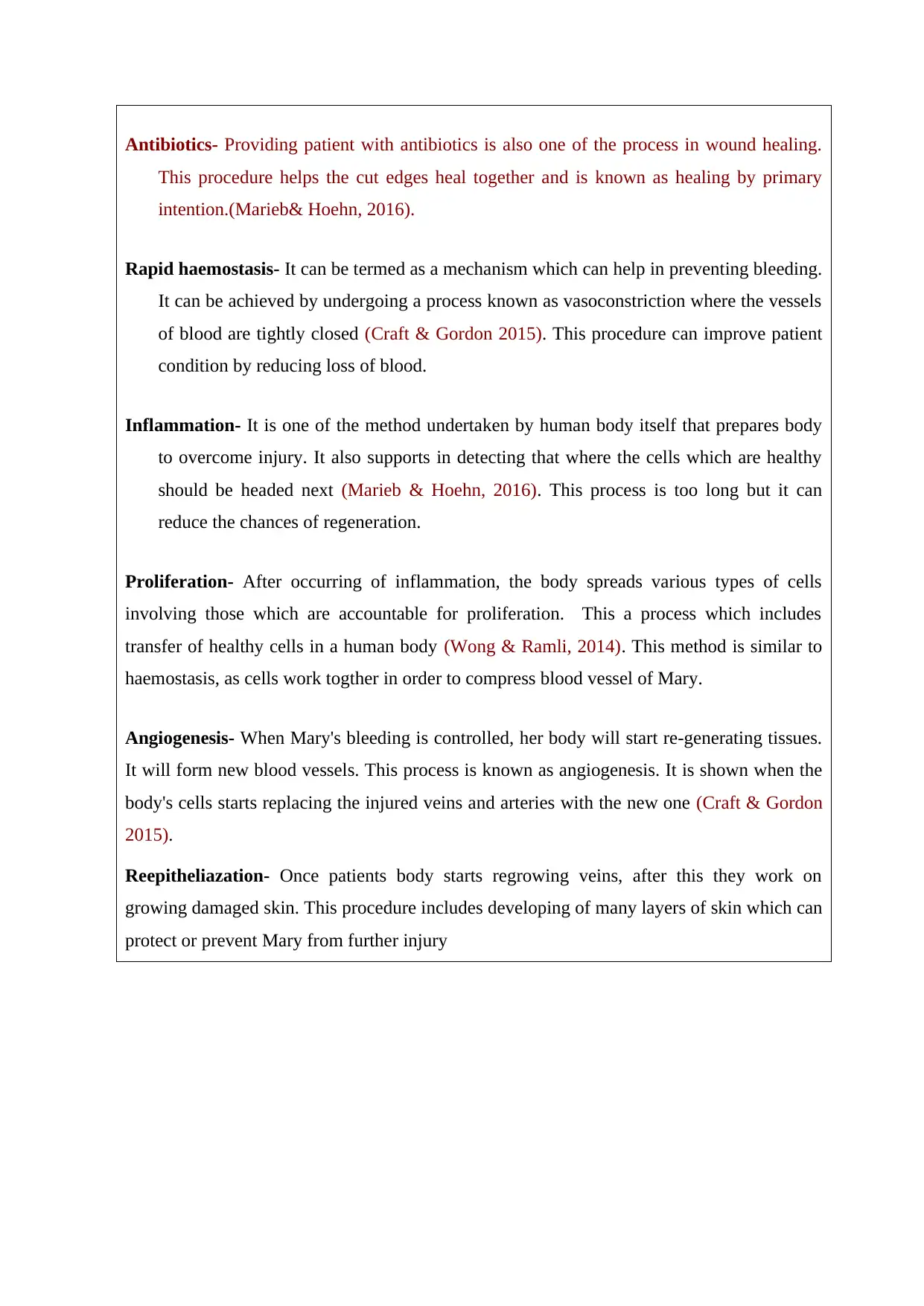
Antibiotics- Providing patient with antibiotics is also one of the process in wound healing.
This procedure helps the cut edges heal together and is known as healing by primary
intention.(Marieb& Hoehn, 2016).
Rapid haemostasis- It can be termed as a mechanism which can help in preventing bleeding.
It can be achieved by undergoing a process known as vasoconstriction where the vessels
of blood are tightly closed (Craft & Gordon 2015). This procedure can improve patient
condition by reducing loss of blood.
Inflammation- It is one of the method undertaken by human body itself that prepares body
to overcome injury. It also supports in detecting that where the cells which are healthy
should be headed next (Marieb & Hoehn, 2016). This process is too long but it can
reduce the chances of regeneration.
Proliferation- After occurring of inflammation, the body spreads various types of cells
involving those which are accountable for proliferation. This a process which includes
transfer of healthy cells in a human body (Wong & Ramli, 2014). This method is similar to
haemostasis, as cells work togther in order to compress blood vessel of Mary.
Angiogenesis- When Mary's bleeding is controlled, her body will start re-generating tissues.
It will form new blood vessels. This process is known as angiogenesis. It is shown when the
body's cells starts replacing the injured veins and arteries with the new one (Craft & Gordon
2015).
Reepitheliazation- Once patients body starts regrowing veins, after this they work on
growing damaged skin. This procedure includes developing of many layers of skin which can
protect or prevent Mary from further injury
This procedure helps the cut edges heal together and is known as healing by primary
intention.(Marieb& Hoehn, 2016).
Rapid haemostasis- It can be termed as a mechanism which can help in preventing bleeding.
It can be achieved by undergoing a process known as vasoconstriction where the vessels
of blood are tightly closed (Craft & Gordon 2015). This procedure can improve patient
condition by reducing loss of blood.
Inflammation- It is one of the method undertaken by human body itself that prepares body
to overcome injury. It also supports in detecting that where the cells which are healthy
should be headed next (Marieb & Hoehn, 2016). This process is too long but it can
reduce the chances of regeneration.
Proliferation- After occurring of inflammation, the body spreads various types of cells
involving those which are accountable for proliferation. This a process which includes
transfer of healthy cells in a human body (Wong & Ramli, 2014). This method is similar to
haemostasis, as cells work togther in order to compress blood vessel of Mary.
Angiogenesis- When Mary's bleeding is controlled, her body will start re-generating tissues.
It will form new blood vessels. This process is known as angiogenesis. It is shown when the
body's cells starts replacing the injured veins and arteries with the new one (Craft & Gordon
2015).
Reepitheliazation- Once patients body starts regrowing veins, after this they work on
growing damaged skin. This procedure includes developing of many layers of skin which can
protect or prevent Mary from further injury
Paraphrase This Document
Need a fresh take? Get an instant paraphrase of this document with our AI Paraphraser
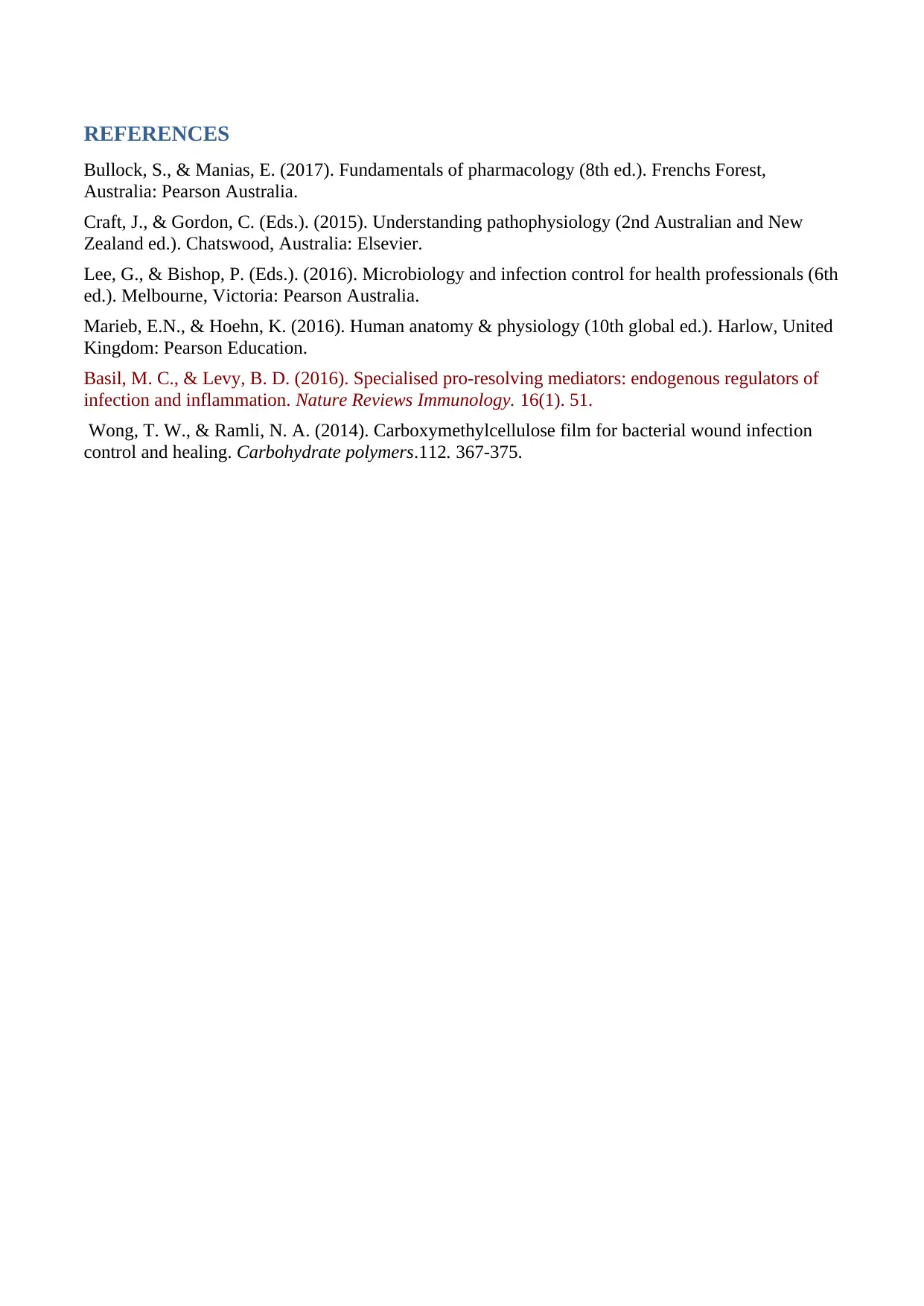
REFERENCES
Bullock, S., & Manias, E. (2017). Fundamentals of pharmacology (8th ed.). Frenchs Forest,
Australia: Pearson Australia.
Craft, J., & Gordon, C. (Eds.). (2015). Understanding pathophysiology (2nd Australian and New
Zealand ed.). Chatswood, Australia: Elsevier.
Lee, G., & Bishop, P. (Eds.). (2016). Microbiology and infection control for health professionals (6th
ed.). Melbourne, Victoria: Pearson Australia.
Marieb, E.N., & Hoehn, K. (2016). Human anatomy & physiology (10th global ed.). Harlow, United
Kingdom: Pearson Education.
Basil, M. C., & Levy, B. D. (2016). Specialised pro-resolving mediators: endogenous regulators of
infection and inflammation. Nature Reviews Immunology. 16(1). 51.
Wong, T. W., & Ramli, N. A. (2014). Carboxymethylcellulose film for bacterial wound infection
control and healing. Carbohydrate polymers.112. 367-375.
Bullock, S., & Manias, E. (2017). Fundamentals of pharmacology (8th ed.). Frenchs Forest,
Australia: Pearson Australia.
Craft, J., & Gordon, C. (Eds.). (2015). Understanding pathophysiology (2nd Australian and New
Zealand ed.). Chatswood, Australia: Elsevier.
Lee, G., & Bishop, P. (Eds.). (2016). Microbiology and infection control for health professionals (6th
ed.). Melbourne, Victoria: Pearson Australia.
Marieb, E.N., & Hoehn, K. (2016). Human anatomy & physiology (10th global ed.). Harlow, United
Kingdom: Pearson Education.
Basil, M. C., & Levy, B. D. (2016). Specialised pro-resolving mediators: endogenous regulators of
infection and inflammation. Nature Reviews Immunology. 16(1). 51.
Wong, T. W., & Ramli, N. A. (2014). Carboxymethylcellulose film for bacterial wound infection
control and healing. Carbohydrate polymers.112. 367-375.
1 out of 5
Related Documents
Your All-in-One AI-Powered Toolkit for Academic Success.
+13062052269
info@desklib.com
Available 24*7 on WhatsApp / Email
![[object Object]](/_next/static/media/star-bottom.7253800d.svg)
Unlock your academic potential
Copyright © 2020–2025 A2Z Services. All Rights Reserved. Developed and managed by ZUCOL.




